We just finished our annual Christmas trip. We always have our share of challenging weather on winter cruises, and this year was no exception. We started with a deep freeze, with temps getting down into the teens. This was followed by freezing rain, leaving half an inch of ice on everything, which was in turn followed by super warm temps and torrential, unending rain for days. These were coupled with super high tides, leading to coastal flooding. Finally, we had hurricane-force winds and local waters filled with detritus and silt on the shortest, darkest days of the year.
I’m pleased to say the boat handled remarkably well. We filled completely up with fuel and water, making us almost 7,000 pounds heavier. The XO* and I both noticed improved stability, especially with waves on the bow and up to almost 45 degrees to either side of the bow. We still had a bad moment when we needed to turn broad-side to the seas to make the harbor entrance – taking a 4’ wave on the starboard quarter caused a roll none of us enjoyed. But, over all the boat handled rough seas better than anticipated.
James once told me, “You can do the best planning in the world, but at the end of the day, your best defense is a tough boat”, and I continue to find that to be true. We never deliberately tackle big seas. We plan conscientiously, wait for weather windows, and identify (and use!) bail-out locations if we get into something we can’t handle. But, if you’re on the water, you will inevitably run into something bigger than you can handle. The NP handled well, but she’s no blue water boat. We took a lot of green water on the pilothouse, and the sliding doors let a fair amount of it in. I continue to debate the comfort vs. toughness tradeoff.
With some small exceptions, noted below, every system worked well this trip. We had 50A power on the dock, and were able to run both hydronic elements and the domestic hot water heater without a single breaker trip. This means we needed to burn far less diesel in the hydronic, which is not only quieter, but seems to have consumed less coolant (due to the pinhole leaks). Over a week of constant use and we only used a quart or two.
Our stay at Alderbrook was uneventful. For all but the last night, we were the only boat on the dock. As always, the resort provided top notch service. Cindy, the old harbormaster, retired. But she was replaced by her nephew, Eric, who helped us pump-out on an off day to avoid the bad weather. While we were sitting with plenty of power and heat at the dock, our land home – and 50,000 other homes – lost power for over 12 hours. Despite some of the rough conditions, we were glad to be on the boat and safely tied up to the dock.
Planning our departure really tested our skills. We were scheduled to depart Tuesday, which was also the day that gale force winds would descend on the region. While we don’t like to have our hands forced, the XO was needed in the Emergency Department on Thursday morning. Plan A was for me and the kids to stay an extra day at Alderbrook, while the XO and the dog caught a (car) ride home with some friends who stayed at the resort over Christmas. Despite the sheltered location, we’d gotten banged around on the dock Monday morning by some SW winds and waves from the west. So, we booked a room for Tuesday so we could all get a good night’s sleep before tackling Wednesday. I and the kids would depart at first light, hoping for a single 10+ hour transit during a weather window, with bail-out plans for Pleasant Harbor, Port Ludlow, or Kingston, if necessary. The XO would stay at Alderbrook and catch a ride with our friends on their way back from Harstine. There were risks here – notably my ability to handle tough seas alone with the kids and whether my stamina would hold out for an 11 hour transit – some of it in the dark through storm-log-filled waters.
But, Tuesday morning arrived surprisingly calm. Working with Predictwind, we found that the winds were coming at the exact right angle to be completely blocked by the Olympics for our transit up the canal. We tried different models at different resolutions and virtually all of them said that we would be fine making it to Ludlow that day. I really wasn’t excited about single-handing the boat with the kids through potentially bad weather. There was also asking our friends to go a hundred miles out of their way to get the XO home. Then, there was the chance that the bad weather wouldn’t break, and I would be stuck with the kids at Alderbrook for several more days. Finally, all of the models showed the Alderbrook dock getting hammered during the storm, so it wouldn’t necessarily have been the safest place, anyway. Ultimately, we decided to not split the party and departed as a full crew on Tuesday.
Through a mix of skill (planning the weather windows and knowing these waters well), luck (the models were right), and humility (we called up for help at the Ludlow dock, since there were brutal cross winds), we had an uneventful transit and were safely tucked in at Ludlow for the gale. We even got a last-minute reservation at the Fireside for dinner. I don’t want to understate our luck. We were in one of the very few safe locations in the Salish Sea on Tuesday evening. We’re the little white dot in that tiny island of calm. Note that the Alderbrook dock at the south end of Hood Canal got hammered. On Tuesday morning, the lower floor of the resort had flooded, so our room would likely have not been available.
Wednesday was a cakewalk and we were safely tucked in at Liberty Bay by lunchtime.

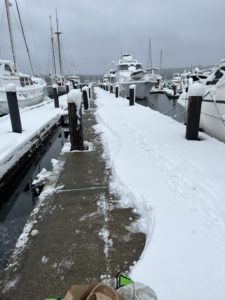
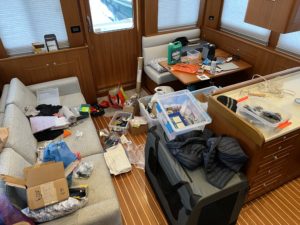


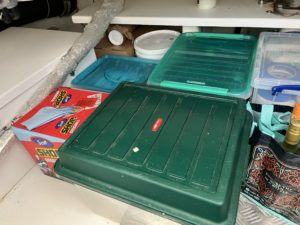
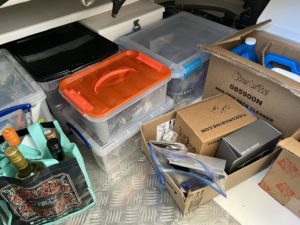


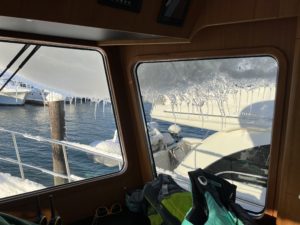
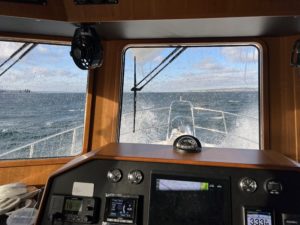

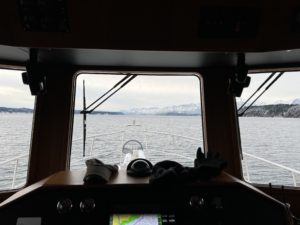
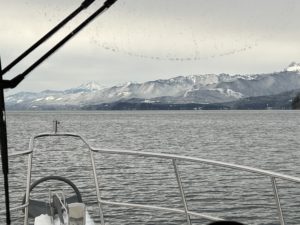

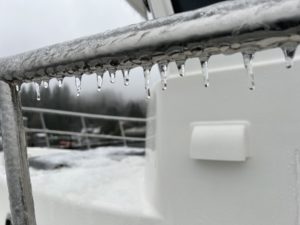

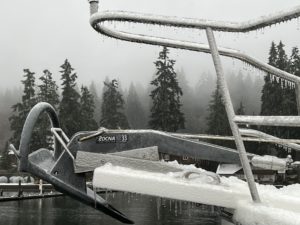


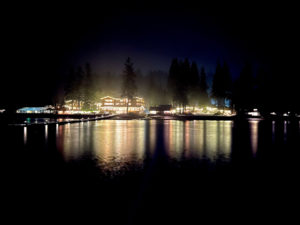

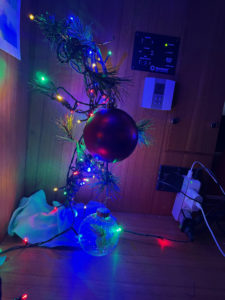
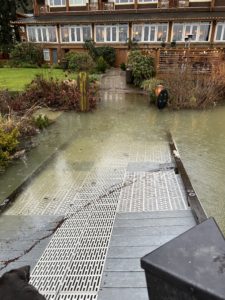

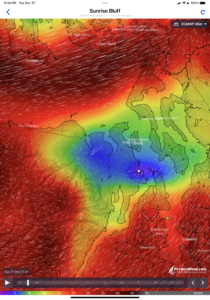

Maintenance stuff
I’m so used to stuff breaking, I feel like I need to emphasize how mechanically uneventful this trip was. The hydronic worked great and didn’t use much coolant. We had no breaker trips. The water maker and generator worked great. The boat handled well. There were three small items.
- I assembled the port pilothouse door latch incorrectly and it started to jam, making the door very difficult to open. I reassembled it correctly – took five minutes.
- The XO noticed a high-pitched sound from the engine room that I did not. A small dab of dielectric lubricant to the shaft brush took care of that.
- We started seeing our own AIS signal as a collision warning on the chart plotter. An Internet search confirmed some other people have seen this, but there were no fixes noted. It cleared up on its own.
That’s it! Not a bad record given the other challenges. I have several other items coming up.
- The high pressure pump oil in the water maker needs changing
- All primary and secondary fuel filters need changing
- Main engine and generator oil need changing
- Hydronic unit swap out
- Blue Sea ELCI breaker replacements
- Serpentine belt inspection
- Finish color matching on aft starboard gelcoat repair
- We also have a new issue with widespread gelcoat discoloration. Working with North Pacific on a plan here.
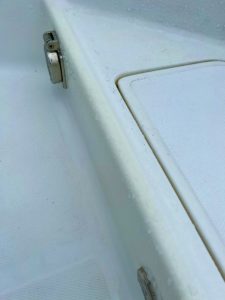
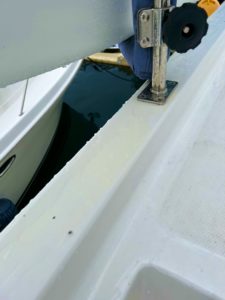


Trip stats
- 149 nautical miles
- 7.1 kts average speed
- 67.2 gallons of diesel consumed (not including hydronic and generator – I use ~10% for those).
- 23 hours on the main (finished at 402)
Annoyances
Final note: In addition to the leaky doors, we’ve identified a couple more design challenges.
First, the midship cabin is becoming more and more difficult as the girls grow. It’s cramped, poorly ventilated, and the location of the heater core pushes most of the heat into the hallway. I’m begining to wonder if we could really all spend a summer together going to Alaska.
Second, the hull design causes water to pool in several locations, notably on the flybridge hardtop, forward of the flybridge helm, on the pilothouse roof, and on the raised bench portion of the bow. During heavy rains, this causes almost constant, loud, splattering on the master suite roof, making sleeping during heavy rain almost impossible. This isn’t the calm steady pattering of gentle rain, but the irregular pounding of a broken water spout. I’ll have to give some thought to how to address this.
*I’m well aware of the vaguely sexist term “admiral” sometimes used to refer to a “boating wife”. I get why it’s annoying and why people shouldn’t use it. That said, over time, the boat has increasingly become my project, with me taking the lead on everything from trip planning, to maintenance, to seamanship, to provisioning. For a while we tried the “co-captain” thing, but way-back-when, when we hired our coach, she called us out immediately. She pointed at me and said “none of this co-captain nonsense. You’re in charge. You’re the captain. If there’s a problem, you’re the one that will be held accountable.” That stuck. It also started feeling weird and condescending when someone would ask us about boat stuff and I would try to include her, but she would always defer back to me. I use my real name on this site, but I wanted to take some small measure to keep her out of the search crawlers and spam bots. So, instead of “admiral” I started using “Executive Officer” or XO. As a Navy kid, she objected that it’s not really a Navy rank, but I found out it actually is, (I discovered it from BSG) and describes perfectly what she does aboard. While I’m on watch, she does pretty much everything else. So, we’ll stick with XO for now.

